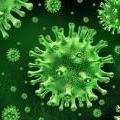The Marburg and Ebola viruses are known to be some of the deadliest bugs on the planet. Due to cunning use of deception and camouflage the virus evades natural defences for a sufficient period to re-group, grow and then overwhelm the body with a massive attack.
It is becoming increasingly evident to scientists that the part of the virus the body's immune system needs to see is the core genetic material. However, the Marburg virus wraps a length of protein over this part of itself rendering it invisible or non-reactive to the immune system.
Marburg causes an extreme form of haemorrhagic fever which affects both humans and non-human primates. Infections normally occur in sporadic outbreaks throughout Africa, but with devastating effects. For example, an outbreak in Angola in 2005-06, which started in a paediatric ward, killed 88% of the children and people infected.
The lab in Marburg, Germany that discovered the virus (and where the lab staff became infected) was using African green monkeys and their tissue to develop a polio vaccine. Marburg belongs to a dangerous family of viruses known as filoviuses, which includes the Ebola virus.
The virus has subsequently been imported into the United States (Colorado) and the Netherlands by tourists returning from Africa. The virus is spread when people come into contact with bodily fluids from an infected person or animal, and there is no cure. Most people die within two weeks, from dehydration, massive bleeding and shock. However, small proportions of people have naturally strong and immediate immune responses and do survive.
The part of the viral nucleic acid that the immune system relies on being able to recognize in order to raise a strong immune response is the double stranded RNA (dsRNA) at the middle of viruses. This is the viruses unique 'signature' and is normally detected by "host sentry proteins".
The good news is that by understanding the way in which these deadly viruses operate, there is now a much better route for developing an anti-viral therapeutic approach.
Source: Medical News Today


